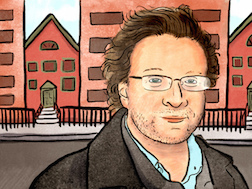On March 27, when news first filtered into Moscow that 39 members of the Heaven’s Gate cult, a gang of Trekkoid computer geeks in San Diego, had “shed their containers” in a suicidal bid to reach the “Higher Level,” eXpats all over the city thought the same thing: man, people at home must really be bored. For eXpats, the news was life-affirming. For many of us, our best excuse for being here is that it gives us, however erroneously, a sense of being a participant in a society where people lead real lives and have real problems. More than one of us has suspected that if we were to go back home, there would be only one road to take to escape the sanitary life the West has to offer-get on the net, and die.
Now, suddenly, we had 39 solid reasons to be sure we were right to move here.
Of course, like America, Russia is rich in bizarre ritualistic cults. A few years ago, Russia even had the distinction of being home to the largest population of the world’s most deadly cultists-followers of Aum Shinriko, which eventually was disbanded after it killed 12 in a sarin gas attack in Tokyo. Strikingly, while it took bearded nerd/murderer Shoko Asahari more than a decade to build a following of 10,000 in Japan, it took just a few years and a small capital investment to attract an army of 30,000 Russians.
Even more embarrassing was the level of governmental assistance Asahari had in Russia; it was the enthusiastic aid of officials like Oleg Lobov and Ruslan Khasbulatov which elevated Aum from the status of a common, if badly-dressed, gang of criminals into a fully armed, James-Bondian criminal superpower.
But even though Russians do join cults en masse, it is the reasons they do so which reassure us eXpats. Deep in our hearts, we know Russia is still decades and dozens of IMF loans away from ever achieving the level of suburban affluent boredom necessary to produce people like the Heaven’s Gate cultists. And we feel sure the peculiarly Japanese phenomenon of overwork and repressed creativity which contributed to Aum’s loopy sci-fi appeal in Japan isn’t likely to motivate too many Russians to put on robes anytime soon.
Instead, Russians join cults for reasons that make sense to us: a longing for material comfort, an unwillingness to pay for English lessons, and the purely self-indulgent habit of shirking worldly responsibilities in favor of bizarre intellectual and spiritual meanderings.
“Russians don’t join cults for the same reasons people in the West do,” said Pyotr Fedorus, a theologian and a member of the Assembly of God church, based in the Vuikhino region. “They do it because they have a long tradition of becoming engrossed in spiritual questions, because they are materially miserable, and because life in this country is so bizarre and inexplicable that sometimes it seems only extreme religious teachings can make any sense out of it.”
“The reason some Russians join cults,” said Vasily Romanyuk, director of the Moscow Theological Institute, “is to get free schooling and trips overseas. It’s sad, but true.”
Ten Reasons Heaven’s Gate Couldn’t Have Happened in Russia:1. Nikes cost 200 bucks a pair. |
But Russians have become pickier about their choice of cults in recent years. Like eXpat men who are finding that their Western passports aren’t getting them as many dates as they used to, huge foreign cults are finding it harder to get Russians to give up their savings and chant in the streets.
Among the more prominent cults to appear in the post-Soviet period, for instance, were Aum, the Hare Krishnas, the Bogorodchichesky Tsentr or Deva Maria cult (see Edward Limonov’s column), and a host of more or less respected Western religions which Russian Orthodox followers consider cults, including the Mormon church, the Jehovah’s Witnesses, and the 7th-Day Adventists. Many of these cults, particularly the Hare Krishnas, were given a lot of initial coverage by Western news agencies who, often as not, reported their appearance as a healthy sign that Russians were becoming more like us.
But three of the better-known new cults-the Deva Marias, Aum, and the anti-Semite nationalist Christian group the White Brotherhood, all of whom had members numbering in the thousands, have since suffered severe blows after criminal prosecutions in Russia and abroad.
Of those, only the White Brotherhood-conspicuously a group based on Russian Orthodoxy- appears to have avoided the knockout punch. Moscow State University professor and member of the Duma committee on religious organizations Igor Kontarov said he believes the wave of visible predatory cults has already passed.
“The White Brotherhood is still active here in Moscow; I meet with them in secret locations,” he said. “But Aum is gone and many of the other foreign influenced cults are seeing their memberships decrease. The ones that are picking up speed are really the ones based on Russian Orthodoxy and other traditional Russian teachings.”
One such group that’s on the rise is the Church of Christ, which in the Russian version is conspicuous as a sect due to its dorky self-referential terminology (it calls its churches or temples “sectors” and divides its members according to a pseudo-military ranking system) and its strict rituals. Church of Christ members, who frequently congregate at the “Oktyabr” movie theater on the Novy Arbat, are required to speak about Christ to at least one stranger every day on pain of expulsion.
Among the weirdest of these fast-growing groups are the so-called Ivanovites, whom some of you may have noticed this winter; they are often seen walking barefoot in the snow early in the morning.
The group ascribes to the teachings of early 20th century Russian philosopher Porfiry Ivanov, who was renowned for his extreme and extremely entertaining asceticism-he rejected all material possessions, including clothes.
Ivanovites today mainly express their religious feeling by skinny-dipping in winter and walking barefoot on snow; it must be more fun than it sounds, because their numbers, theologians say, are growing.
“The Ivanovites are everywhere,” said Yevgeny Sandler, another Assembly of God theologian. “It’s one of these groups that offers an unusual ritual that people feel comfortable complying with.” He estimated that there are close to a thousand in Moscow today.
Ivanov’s doctrine was a stylistic improvement on the time-tested Russian method of attracting followers by tapping into the vast reserves of national self-loathing that were generally there for justifiable political and socio-economic reasons.
In the nineteenth century, Russians (and particularly aristocrats) were so tortured by feelings of guilt and failure that the teachings of the skoptsi, which in the 1870s began to make castration a prerequisite for sect membership, actually attracted a wide following.
The khlisty, a group which in a clever marketing package combined self-flagellation with orgiastic rituals, eventually stole the momentum of the skoptsi, who, predictably, died out at the turn of the century.
But eventually the khlisty and most other cults were forced to give way to the biggest silly cult of all, the Communist Party, which itself demonstrated clearly that Russia is a country where social misfits congregating in basements can have ambitions that go far beyond mere container-shedding.
Russia has a long tradition, incidentally, of weirdo meetings in basements; one of the origins of the popovtsi or Old Believers’ sect (another group of extreme ascetics which, incidentally, still has a population in Alaska) were fifteenth-century meetings in underground storage rooms. Popovtsi were even sometimes called golubtsi, after a Ural moutain region slang word for basement, where Old Believers met and hid as a means of renouncing the outside world.
Centuries later, after ex-basement dweller Joseph Stalin’s “Socialism in One Country” policy formalized Russia’s passion for ascetic withdrawal from the outside world, his party banned all cult activity. However, it was notoriously unsuccessful.
In August, 1950, for instance, the so-called True Orthodox Church (IPTs) sect poked its head out in the village of Stayevo in the Tombov oblast to reaffirm yet another great Russian passion, that is, the working out of profound moral questions using axes.
Sect leader Vasily Ryakhovsky convinced followers that judgement day was coming and that his church had been ordained by God to dispense punishment. They started by breaking up furniture, then moved on to the chopping up of human beings, eventually killing three (starting, of course, with an elderly woman) and burning down a house before they were arrested by Soviet security officials-who, naturally, tortured them in a basement.
All in all, however, the evolution of self-castrating skoptsi into today’s footwear-eschewing Ivanovites goes a long way towards showing how mellow Russia’s cult scene has become in recent years.
Pogroms carried out by Orthodox sects used to be common in Russia; today, while both the White Brotherhood and the Bogorodi-chesky Tsentr have claimed responsibility for mining synagogues in recent years, neither have undertaken mass murder or terror.
In fact, the biggest indulgences for would-be Russian sectarians these days are the betrayal of Russian Orthodoxy for Western religions like the Mormon church, which offer materially prosperous role models and attractively goofy rituals like the legendary Mormon secret underwear, formally known as “temple garments.”
“Many people, when they are introduced to the Mormon church, are attracted to the idea of secret underwear,” said Sandler. “People who are destined to be in sects like two things; special words and special rituals. For rituals, you can’t get much better than secret underwear.”
That’s the charm of this country; it’s a place where secret underwear still has some appeal. Americans went through that phase decades ago through mass sales of colored “Underoos.”
Now corporations at home have nothing left to sell us besides cyanide and Internet services. Nothing else will do-unless we decide to stay here another year.
This article was published in Issue #5 of The eXile, April 1997.
Read more: eXile Classic, exile issue 5, Matt Taibbi, eXile Classic


Got something to say to us? Then send us a letter.
Want us to stick around? Donate to The eXiled.
Twitter twerps can follow us at twitter.com/exiledonline















1 Comment
Add your own1. Janette | April 15th, 2015 at 1:45 pm
Hi my name is Janette and I just wanted to drop you a quick note here instead of calling you. I came to your Russia
Leave a Comment
(Open to all. Comments can and will be censored at whim and without warning.)
Subscribe to the comments via RSS Feed